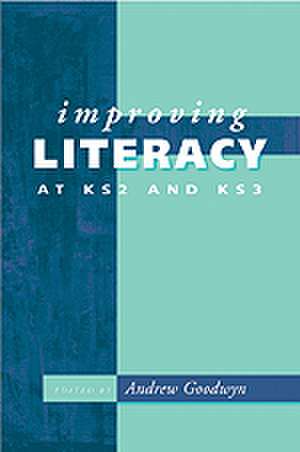Improving Literacy at KS2 and KS3
Editat de Andrew Goodwynen Limba Engleză Electronic book text – 16 sep 2010
This book will to help students and practising teachers to understand the issues surrounding literacy, the place of transition in pupils' lives, and to feel confident in handlingThe National Literacy Strategy.
The book focuses on the crucial period when children complete primary schooling and begin in secondary schools. It examines the issue of transition from one phase to the other and specifically, the nature of literacy at this period. The authors contrast the `whole school' approach of primaries to the very subject-specific nature of secondary teaching.
The authors set the NLS in perspective, reviewing earlier movements such asLanguage across the Curriculumand the NLS itself. They offer a critique of the strategy and outline its strengths and weaknesses. The book sets out evidence of the way schools are reacting to the NLS, and what classroom teachers and their pupils think. Its coverage is comprehensive and includes focus on primary, secondary and middle schools, the teaching of literacy and English, the role of ICT, as well as important areas such as media education, drama and modern foreign languages.
This book will be useful to education students and to practicing teachers in primary and secondary schools.
Preț: 255.93 lei
Nou
Puncte Express: 384
Preț estimativ în valută:
43.21€ • 45.12$ • 35.68£
43.21€ • 45.12$ • 35.68£
Indisponibil temporar
Doresc să fiu notificat când acest titlu va fi disponibil:
Se trimite...
Preluare comenzi: 021 569.72.76
Specificații
ISBN-13: 9781412932189
ISBN-10: 1412932181
Pagini: 214
Dimensiuni: 156 x 234 mm
Ediția:First Edition
Editura: SAGE Publications
Colecția Sage Publications Ltd
Locul publicării:London, United Kingdom
ISBN-10: 1412932181
Pagini: 214
Dimensiuni: 156 x 234 mm
Ediția:First Edition
Editura: SAGE Publications
Colecția Sage Publications Ltd
Locul publicării:London, United Kingdom
Recenzii
`Improving
Literacy
at
KS2
and
KS3is
all
about
primary-secondary
transfer,
seen
mostly
through
the
eyes
of
secondary
teachers,
but
with
some
interesting
contributions
from
middle-school
staff
who
know
the
territory
well.
This
book
sees
the
NLS's
influence
on
primary
practice
as
generally
benign,
but
takes
a
more
jaundiced
view
of
the
implications
for
secondary
teaching,
especially
in
its
central
chapter
"Evidence
from
experienced
practitioners".
There
are,
however,
many
useful
suggestions
for
reshaping
and
adapting
parts
of
the
strategy,
including
chapters
on
classroom
literacy
and
everyday
life
and
literacy
and
drama
which
consider
ways
of
relating
learning
to
the
wider
culture
beyond
school,
including
screen-based
literacy.
There
is
also
a
review
of
the
language-across-the-curriculum
movement
and
a
chapter
on
subject
literacies
which
has
left
me
with
an
abiding
admiration
for
geography
teachers
as
lone
voices
of
dissent'
-Sue
Palmer,
TES
Teacher
Cuprins
Introduction
-
Andrew
Goodwyn
Literacy in Transition - Andrew Goodwyn and Kate Findlay
Secondary Schools and the National Literacy Strategy - Andrew Goodwyn and Kate Findlay
Subject Literacies - Kate Findlay
Literacy at Key Stage 3 - Michael Lockwood
Evidence from Experienced Practitioners - Winston Brookes
Classroom Literacy and Everyday Life - George Hunt
Literacy and Drama - Lionel Warner
Literacy and Modern Foreign Languages - Cynthia Martin
Literacy and Subject Knowledge - Margaret Perkins
Literacy in Transition - Andrew Goodwyn and Kate Findlay
Secondary Schools and the National Literacy Strategy - Andrew Goodwyn and Kate Findlay
Subject Literacies - Kate Findlay
Literacy at Key Stage 3 - Michael Lockwood
Evidence from Experienced Practitioners - Winston Brookes
Classroom Literacy and Everyday Life - George Hunt
Literacy and Drama - Lionel Warner
Literacy and Modern Foreign Languages - Cynthia Martin
Literacy and Subject Knowledge - Margaret Perkins
Descriere
`Improving
Literacy
at
KS2
and
KS3is
all
about
primary-secondary
transfer,
seen
mostly
through
the
eyes
of
secondary
teachers,
but
with
some
interesting
contributions
from
middle-school
staff
who
know
the
territory
well.
This
book
sees
the
NLS's
influence
on
primary
practice
as
generally
benign,
but
takes
a
more
jaundiced
view
of
the
implications
for
secondary
teaching,
especially
in
its
central
chapter
"Evidence
from
experienced
practitioners".
There
are,
however,
many
useful
suggestions
for
reshaping
and
adapting
parts
of
the
strategy,
including
chapters
on
classroom
literacy
and
everyday
life
and
literacy
and
drama
which
consider
ways
of
relating
learning
to
the
wider
culture
beyond
school,
including
screen-based
literacy.
There
is
also
a
review
of
the
language-across-the-curriculum
movement
and
a
chapter
on
subject
literacies
which
has
left
me
with
an
abiding
admiration
for
geography
teachers
as
lone
voices
of
dissent'
-Sue
Palmer,
TES
Teacher
This book will help student and practising teachers to understand the issues surrounding literacy, the place of transition in pupils' lives, and to feel confident in handling the NL (National Literacy Strategy). The book focuses on the crucial period when children complete primary schooling and begin in secondary schools. It examines the issue of transition from one phase to the other and specifically, the nature of literacy at this period.
This book will help student and practising teachers to understand the issues surrounding literacy, the place of transition in pupils' lives, and to feel confident in handling the NL (National Literacy Strategy). The book focuses on the crucial period when children complete primary schooling and begin in secondary schools. It examines the issue of transition from one phase to the other and specifically, the nature of literacy at this period.
